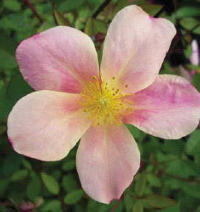| Classification | China |
|---|---|
| Year Introduced | Prior to 1894 |
| Size Category/Growth Habit | Medium shrub |
| Height | 6 feet |
| Width | 6 feet |
| Spacing | 8 feet apart on centers |
| Color | Yellow, changing to pink, and finally to crimson |
| Bloom | Single blossoms that have an almost silken quality. Successive flushes of bloom spring, summer, and fall. |
| Fragrant | No |
| Planting Site | Full sun. Good air circulation. |
| Water Use | Keep moist until established (usually requires one month to establish). Average water needs during growing season. Appears to tolerate highly saline irrigation water when drip irrigated. |
| Cold Hardiness | Hardy in zones 6-9 |
| History | Was once sold as ‘Tipo Ideale’. |
Mutabilis was introduced prior to 1894 and is one of the most famous and beloved of the old garden roses. Amazing medium sized single blossoms that pass through three distinct color phases (hence the name Mutabilis, since the blooms “mutate” in color) beginning with yellow, changing to pink, and finally to crimson. Mutabilis is also known as “The Butterfly Rose” because its blossoms look like brightly colored butterflies that have landed on the bush. Named 2005 “Earth-Kind® Rose of the Year” by Texas AgriLife Extension Service, this is a large, attractive shrub that is supremely easy to grow and has great heat tolerance making it well suited for growing in the South. Be sure to give it plenty of room to grow. Can also be pruned to form a spectacular rose tree 8′ to 10′ in height.

Landscape Uses
The flowering characteristics of Mutabilis are what make it uniquely attractive. The silky blooms open pale yellow in color and slowly change to shades of pink and eventually crimson. When a plant is in full bloom with these multi-colored flowers it appears to be covered with butterflies.
Mutabilis is an extremely versatile and vigorous rose cultivar. Plants make an excellent hedge or mass planting. This cultivar needs ample room to provide maximum landscape performance.


